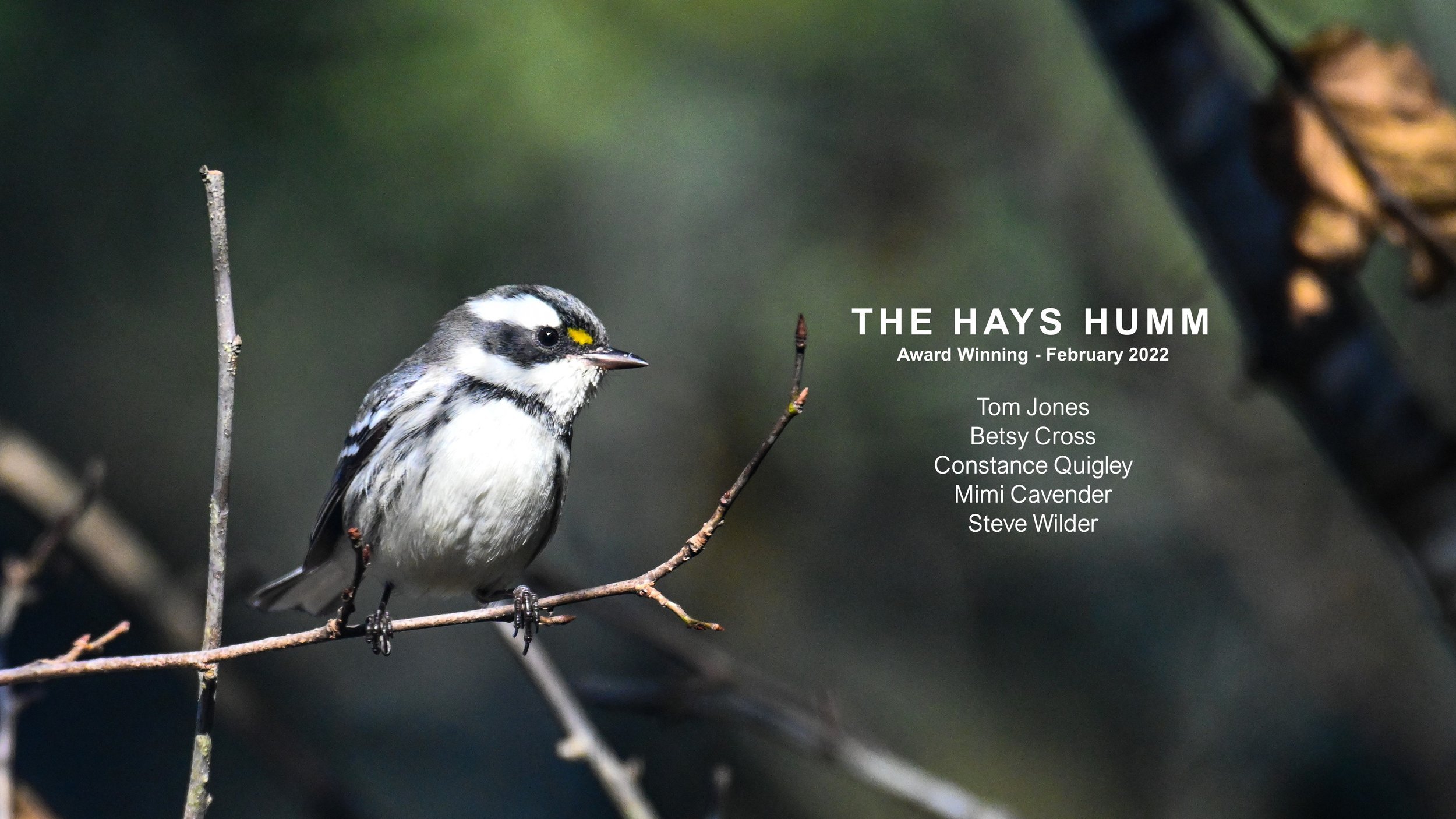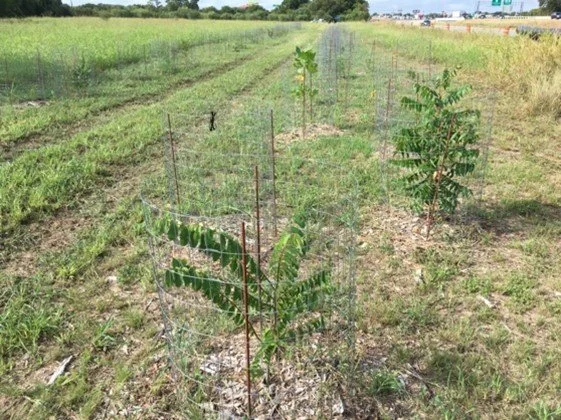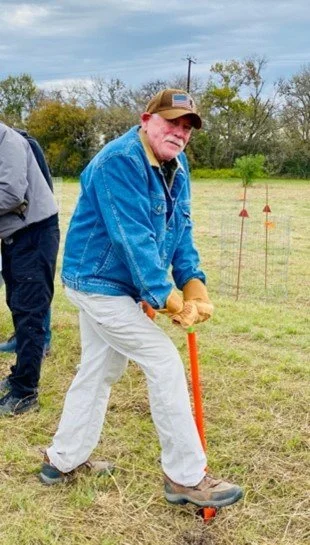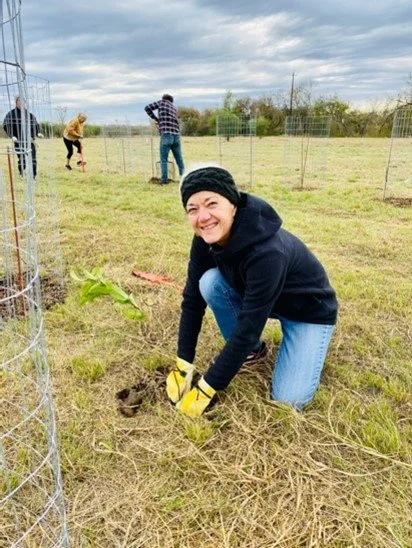The Hays Humm - February 2022
“I’m putting in a potato bed in my garden. Look what I found as I started the second half of the bed. It’s flint on limestone. I think the bed will have to be rerouted. 😁”
When I read Patty’s text, I knew I needed a closer look. Patty’s excavation of an intact flint bed overlying a limestone layer was quite a sight. We share a love of rocks. I first met Patty in 2018 as I prepared to lead a HaysMN training class site visit at her property. She showed me her extensive rock collection and asked me about how flint was formed and what created the unusual shapes.
This visit was to take a closer look at the recently discovered flint deposits on her property. Flint is a variety of chert that occurs across the central portion of Hays County. It is a hard, glass-like mineral formed from the silica (quartz) rich skeletal remains of marine organisms. Both the flint and limestone were formed in a shallow sea at about the same time. That is why flint is typically found embedded in limestone.
The many flakes and chips scattered across Patty’s property display a wide variety of shapes and colors. The typical colors are shades of gray, brown, light green, blue, and on rare occasions red. A few geodes are also found here but not in the quantity that I have seen at other locations in Hays County.
The four rocks below were discovered within a small area on Patty’s property. They are good examples of the many shapes and colors of flint and limestone.
Flint boulder with a fossilized ammonite and a blood red patch
This large boulder shows the many colors of flint. It has a rusty dark brown exterior, with a white cream colored interior. The red patch is rare and not often seen in flint.
This is a good example of a flint nodule that formed within the limestone.
Black flint and limestone
The black flint looks like glass, which is embedded into the limestone boulder. The black flint appears similar to another mineral, “obsidian,” used by native populations in the Texas Panhandle for arrowheads and spear points. The difference is that obsidian is formed in volcanos and flint is from the sea.
This is an interior view of the ledge flint in the title block photo.
The weathered exterior hides the blue flint outer layer with its brown interior.
The black flint is a very nice find and is a good example of how the flint and limestone were created at about the same time. It has a glass-like appearance, which is not surprising since both the flint and glass are created from silicon. Silicate minerals account for 90% of the Earth's crust. The presence of geodes is also common in many areas of Hays County. Check out my earlier article Wilder Geodes to learn more about these interesting rocks.
“I will not live long enough to fully appreciate what is on my property.”
Photo by Lance Jones
“Preserving and protecting the natural beauty, flow, and purity of the San Marcos River”
Six Hays County Master Naturalists were among the 20 people enduring strong winds on December 11 to participate in the second annual tree planting on the San Marcos River Foundation’s Eastside Preserve property. The Eastside property comprises 32 acres along the San Marcos River where I-35 crosses the river. San Marcos River Foundation (SMRF) plans to keep the property as a natural area and gradually improve it with invasive removal and diversity improvements.
Trees were provided free by One Million Trees Across Texas again this year. They believe the state should be proactively investing in planting trees, especially along highways and in highly trafficked parts of the state. This project was their first one last year, and we were so successful that they were pleased to provide another 100 trees this year (and more next year). 110 trees were planted one year ago with about 75% surviving thus far. Hays County Master Naturalists Malcolm and Barbara Johnson, JoEllen Korthals, Jack Downey, Matthew Fagan, and Dick McBride enjoyed the morning along with 14 “civilians.”
One of the main reasons for our successful first year was the dedication of Malcolm and Barbara Johnson, who regularly watered the trees all year. They plan to continue watering the original trees but will be helped next year by Jack Downey, who has accepted the job of watering the new trees.
Thank You Contributors
Patty Duhon, Jesse Huth, Elizabeth McGreevy, Lance Jones, Dick McBride, Colton Robbins, Rebekah Rylander
Read more about Elizabeth and her journey here.
“December’s full Moon is most commonly known as the Cold Moon—a Mohawk name that conveys the frigid conditions this time of year, when cold weather truly begins to grip us.” — The Old Farmer’s Almanac
And so with December’s Cold Moon still high in the sky, it was quite gripping when we arrived at Freeman Ranch on December 19 to count the birds.— Betsy Cross
Lance Jones and Betsy Cross
“I am excited to let y’all know that despite the frigid temperatures early in the morning, the San Marcos Christmas Bird Count was quite successful! We ended up with 121 species for the count (120 if you exclude the exotic Egyptian Goose), and of those species 6 were considered ‘rare’ for this area.”
This year’s Christmas Bird Count was held on a blustery, cold December 19th. The annual event has been conducted in San Marcos for the last six years, with Rebekah Rylander organizing and participating in the event and tabulating the data collected by multiple teams of birders each year.
The 53 participants fanned out in a 15-mile radius around San Marcos. Starting at sunup, some teams worked the full day. These citizen scientists included university students, Master Naturalists, and local residents who simply enjoy getting outdoors with a purpose. The six natural areas, the Freeman Ranch, downtown San Marcos, private properties (with permission of the landowners), and public roadsides were the scope of the count.
At the end of the day the birders gathered at Chuy’s for a wrap-up dinner to report their sightings, both numbers and unusual birds.
San Marcos Christmas Bird Count - December 19, 2021 Zones Covered
Zone 1 Leader - Jesse Huth
Zone 2 Leader - Justin Bosler
Zone 3 Leader - Anna Matthews
Zone 4 Leader - Romey Swanson and Shelia Hargis
Zone 5 Leader - Kenneth Bader
Zone 6 Leader - Christina Farrell
Zone 7 Leader - Colton Robbins
Zone 8 Leader - Rebekah Rylander
Rebekah Rylander: “This year was comparable to previous years, as we are normally in the 120s. A couple of ‘missed species’ that we usually see included Bufflehead, Neotropic Cormorant, Barred Owl, Great Horned Owl, and Hutton’s Vireo. Perhaps they were all hiding because of the chill. Six species were considered ‘rare’ for this area:
Common Goldeneye: Zone 1
Bald Eagle: seen in Zones 1 and 7
Zone-tailed Hawk: Zone 1
Clay-colored Sparrow: Zone 2
Eastern Towhee: Zone 6 (but viewed by participants in Zone 2)
American Woodcock: Zone 8
And I wish I had laser-fast reflexes in the dark to get a picture of the American Woodcock! They are super cute and cryptic. I have seen one before in San Marcos, but they are considered ‘rare,’ as you never know where you'll find one, and they are never in our area in large numbers. So I was lucky!”
Colton Robbins, who led Team Seven, said of the group’s sighting of a bald eagle, “The degree of white in the tail and head feathers puts this bird at around 3 years old, still 1.5 years away from full mature plumage.”
Anna Matthews, Zone 3 Leader at Freeman Ranch: “Overall it was a pretty slow day and very low in numbers and diversity compared to what I've seen out there in the past. We never did have a huge robin flock or waxwing flock, and our one meadowlark remained lonely. We ended up with 29 species total at Freeman and on our stretch of Fulton Ranch Road. Overall a rough CBC for birds in our section and fewer species than I can usually dig up, but sometimes you just have an off day for birds. It sounds like other groups had similar experiences too. I do have to say though that I don't think I've ever seen that many Vesper Sparrows in one short period of time like that!”
Jesse Huth, Zone 1 leader: “Despite the cold we still had a fun day out birding. And while overall individual numbers were lower, we still managed to find a similar number of species to previous years and encountered a few nice surprises. The Common Goldeneye was not at all something I expected on this count and was a gorgeous breeding plumage male to boot! We had a nice flyover of an immature Bald Eagle, and after comparing photos it appeared to be the exact same individual seen by Team Seven that same day. And finally, after checking every Turkey Vulture throughout the day, we managed to spot our final rarity of a Zone-tailed Hawk (see Jesse’s photo in the gallery). Just goes to show that you don't need perfect weather or an exotic location to have an enjoyable day of birding.”
Did you know…In the latter part of the 19th century, it was common practice for sports hunters to hold a competition on Christmas Day to see who could shoot and kill the most birds. But Frank Chapman (1864-1945), an early conservationist and self-taught ornithologist, did not agree with this tradition. So he proposed “…a new kind of Christmas side hunt in the form of a Christmas bird census…That first year, on Christmas Day, 1900, 27 bird watchers in 25 locations from Connecticut to California counted common loons and killdeer, winter wrens and red-winged blackbirds.”
In her beautifully illustrated children’s book, Counting Birds: The Idea That Helped Save Our Feathered Friends, author Heidi E. Y. Stemple continues:
“[Frank Chapman] was the associate Curator of Mammals and Birds before becoming the Curator of Birds in 1908 at the American Museum of Natural History. His magazine, Bird-Lore, eventually became Audubon Magazine, which is still published today.
In the modern Audubon Christmas Bird Count, each count area is a circle. A map point is identified and a circle with a diameter of 15 miles is drawn around it. This is the count circle. In November, birders sign up to participate in the count with local bird clubs and Audubon Societies. During one 24-hour period on a day between December 14 and January 5, each circle counts birds, compiles data, and reports to the National Audubon Society.
In 2016, which marked the 117th count, 73,153 birders (62,677 in the field and 10,476 at feeders) participated in 2,536 count circles. They counted 56,139,812 birds from 2,636 different species. Frank Chapman would be very happy with these results.”
Following the San Marcos Christmas Count, collated data from our December 2021 count was sent to Audubon and merged with that from other groups’ to create a snapshot of bird populations around the Americas. The most abundant birds sighted in our count circle were red-winged blackbirds (4,045), great-tailed grackles (1,494), black vultures (578), and European starlings (449). See the final tally below our photo gallery.
“From December 14 through January 5 each year tens of thousands of volunteers throughout the Americas brave snow, wind, or rain, and take part in the effort. Audubon and other organizations use data collected in this long-running wildlife census to assess the health of bird populations, and to help guide conservation action. The long term perspective is vital for conservationists. It informs strategies to protect birds and their habitat, and helps identify environmental issues with implications for people as well.” — National Audubon Society
Click on any photo below to enlarge it and scroll through this gallery. Photos were contributed by Rebekah Rylander, Colton Robbins, Jesse Huth, Lance Jones, and Betsy Cross.
Zone 8 Team on the Blanco River
Rebekah Rylander
Vesper Sparrow
Betsy Cross
Golden-fronted Woodpecker
Betsy Cross
Northern Mockingbird
Betsy Cross
American Kestrel
Betsy Cross
Team 3 spotted a rare rainbow
Betsy Cross
Colton Robbins and Zone 7 Team with Game Warden Brandon Pearson
Lance Jones
Loggerhead Shrike
Colton Robbins
Savannah Sparrow
Colton Robbins
Zone 7 Team
Lance Jones
Red-winged Blackbirds
Colton Robbins
Zone 3 Leader Anna Matthews (right) scanning the pasture at Freeman Ranch
Betsy Cross
White-crowned Sparrow
Betsy Cross
Spotted Towhee
Betsy Cross
Mourning Dove
Betsy Cross
Orange-crowned Warbler
Betsy Cross
Zone-tailed Hawk
Jesse Huth
Bald Eagle
Colton Robbins
Inca Dove
Colton Robbins
Red-tailed Hawk
Colton Robbins
Zone 8 Team
Rebekah Rylander
Chillin' at Chuy's
Photo courtesy of Rebekah Rylander (front right)
Final Tally of the San Marcos Christmas Bird Count

















